Twenty-five-minute aircraft turnarounds, as many passengers packed on board as possible. Sounds like a modern budget airline, doesn’t it? Well, you’d be half-right. The budget bit is entirely correct, the modern part isn’t. This was low-fare air travel 1960s-style, getting the very most out of the equipment.
Channel Airways’ founder Sqn Ldr Reginald ‘Jack’ Jones AFC was offering cheap flights long before Sir Freddie Laker launched his ground-breaking Skytrain. Many of his business practices, what’s more, have been adopted by today’s low-cost airlines. But, as it turned out, expansion into jets was a step too far — spectacular colour schemes, long before easyJet, or not.

Jones was one of the first — he may even have been the first — to offer package holidays by air. He was also known for making his assets sweat, and for working his staff hard, too. Geraldine ‘Gerry’ Kay, a stewardess, said, “I loved every minute of my time at Channel Airways. We used to see a lot of Jack Jones. He was always prowling around. He certainly got his pound of flesh from us through the hours we worked.”
It started when Jones was 22. He bought himself out of the Royal Navy when he was refused a transfer to the Fleet Air Arm. Rejected initially by the RAF, he eventually found himself flying torpedo bombers, and testing balloon cables at the Royal Aircraft Establishment earned him his Air Force Cross. He ended the war flying supplies to partisans fighting the Germans in Yugoslavia.
Having spent his RAF gratuity on government surplus aircraft, Jones formed East Anglian Flying Services on 16 August 1946. That day he started joy-riding operations with de Havilland Puss Moth G-ABKZ from a field at Herne Bay, offering sightseeing trips around Canterbury cathedral at 10s (50p) a time.
The business enlarged, and in January 1947 Jones moved to the newly reopened Southend municipal airport. The airline took delivery of four de Havilland Dragon Rapides the following year and later began Southend’s earliest scheduled operation, a regular feeder service to Rochester as part of an ‘associate’ agreement with the state-owned British European Airways. Jones also applied for a licence to fly to Ostend but, as Flight reported, “This was refused, so he hit upon the idea of linking up with an hotel and operating some of the very early inclusive-tour [IT] flights”. Michael Steed, the Southend Standard’s airport reporter at the time, believed Jones operated Britain’s first air package holiday in 1948. But economic difficulties made the going hard for independent airlines, and Jones had to revert to offering pleasure flights from a seafront kiosk at Southend.

As conditions improved, so aircraft could be restored to service. Further Rapides enabled more new services to be launched, while the company took a lease on Ipswich Airport in 1954 and inaugurated operations from there. Three ex-West African Airways DH Doves arrived and a maintenance base was established at Southend. By the end of 1957 East Anglian Flying Services was carrying 30,000 passengers per annum. The new equipment kept on coming: two Bristol 170s, a pair of Vickers Vikings — with which the airline began a London-Paris coach-air service — and, to open the new decade, Douglas DC-3s. Then came its first four-engined aircraft, DC-4 G-ARYY. It was to remain on strength until 1970.
The name change officially took place during 1962. A Rapide had displayed the new moniker as far back as 1952, and Flight reported East Anglian Flying Services was “now dead”. The journal added, “The name — always on their aircraft anyway — is henceforth Channel Airways, there being no longer any confusion with now defunct name Channel Air Bridge.”
Major growth followed the acquisition of an ailing rival, Southend-based Tradair, which had 11 Vikings and two Viscount 707s. Channel Airways was carrying in excess of 250,000 passengers come the end of 1963, and bidding for the remainder of BEA’s Viscount 701 fleet. They began entering service in 1964 to replace the Vikings. Four 62-seat Avro 748s were ordered in 1965, and the following February G-ATEJ operated the type’s maiden flight for Channel, a Southend-Jersey schedule.
It was also announced that Channel was buying Continental Airlines’ entire fleet of Viscount 812s, a total of 11 aircraft plus spares at a cost of £3 million. The first, registered G-ATUE, arrived at Southend in April 1966 and made an appearance at that year’s Biggin Hill Air Fair. The resulting expansion of IT operations enabled Channel to reach the magic half-million passenger mark.
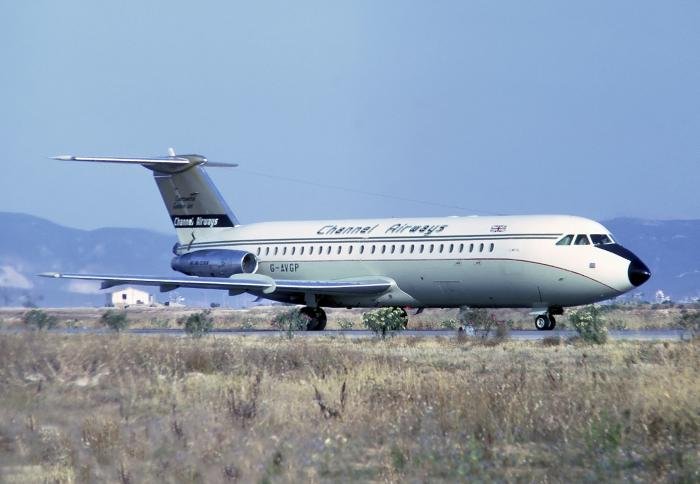
Never one to spend money unnecessarily, Jones retained Continental Airlines’ gold livery on the Viscounts and had it applied to other new aircraft — such as Channel’s jets. Four BAC One-Eleven 400s were ordered with an option on two more. The initial machine arrived in 1967 and G-AVGP flew its inaugural service in June from Southend to Palma.
Channel did something no British independent airline had ever done before in October 1967 when it ordered Hawker Siddeley Tridents, agreeing terms for no less than five at a price of £8 million. The final Trident 1Es built, they had been unsold and awaiting a buyer when Jones visited Hatfield accompanied by the airline’s Stansted station manager, Mike Kay. It seems Jones did a good deal. “He got them at fire sale prices”, Kay recalled to the author. But when they were delivered to Stansted, they came without some of the necessary ground equipment. “We even had to borrow steps”, Kay said.
The aircraft had seating for 139 with 31in pitch and were designated as Trident 1E-140s. Gross weight was increased by 1,500lb and the increased capacity was achieved through creation of a unique seven-abreast, single-aisle seating layout in the forward cabin. The range of the new variant with a full payload of passengers and baggage was 1,930 miles, which increased to 2,570 miles with 100 passengers. Jones was apparently so excited about his Tridents that, at the signing ceremony in London, he said to Sir Arnold Hall and Sir Harry Broadhurst of Hawker Siddeley, “If you can’t get that Trident 3 order from BEA, perhaps we can get together to talk about Trident 3-140s.”
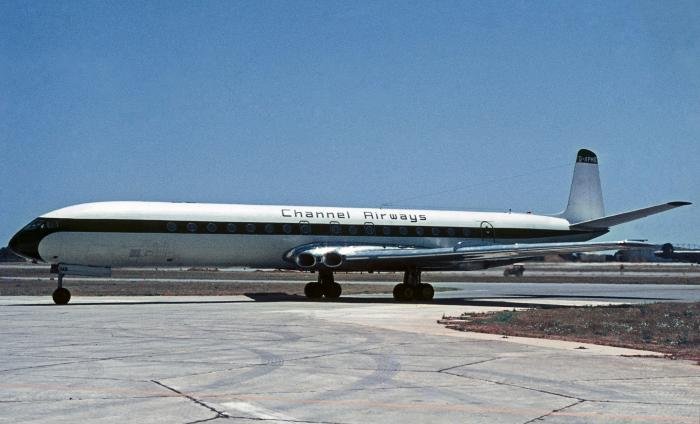
But by the time G-AVYB was delivered on 31 May 1968, such thoughts had gone out of the window, and the airline was trying to renegotiate its order down to just two examples. The second, G-AVYE, joined it the following month and displayed at that year’s Farnborough show. ‘Yankee Bravo’ commenced operations on 13 June, with an IT flight from Stansted to Barcelona via Teesside. It returned the next afternoon.
The two Stansted-based Trident ‘Continental Golden Jets’ were operated on charters to the Canary Islands and Mediterranean resorts like Palma, Ibiza and Rimini. Channel claimed its three-hour 15-minute Stansted-Las Palmas service by Trident represented the fastest way of getting from Britain to the Canaries. The Tridents were seen at a variety of other British airports. In 1969 ‘Yankee Echo’ became the largest jet yet to operate from Bristol’s Lulsgate airport, from where the airline undertook IT services to Gerona.
Meanwhile, Jones was hatching plans for a domestic ‘bus stop’ service to link Southend and Aberdeen with intermediate stops at places like Leeds-Bradford, Teesside, Newcastle and Edinburgh. East Midlands would act as a mini-hub, connecting the service with Norwich, Bournemouth and the Channel Islands. In October 1967 Flight’s reporter joined a party of local dignitaries aboard a One-Eleven for a trial flight. When he suggested Britain might be “too small to justify such services”, Jones replied, “I don’t know, we’ll try it and see”. But the operation wasn’t launched until January 1969, when it was called the ‘Scottish Flyer’. Operated by 69-seat Viscount 812s modified with a large baggage compartment outside the passenger cabin, there were two daily services in each direction.
“It was one of Jones’s real innovations”, said Mike Kay. “There were five-minute turnarounds. They kept the two right-hand engines running; passengers carried their own baggage on board and placed it in a special hold in the cabin area. Small freight was also carried on board. Vauxhall Motors was one of our customers.”
The ‘Scottish Flyer’ was halted in November 1968. Jones decided to cut his losses on an operation which didn’t look like it would ever pay its way. “The problem was the overheads were too high”, commented Mike Kay. “The amount of cycles it put on the aircraft increased maintenance costs.”
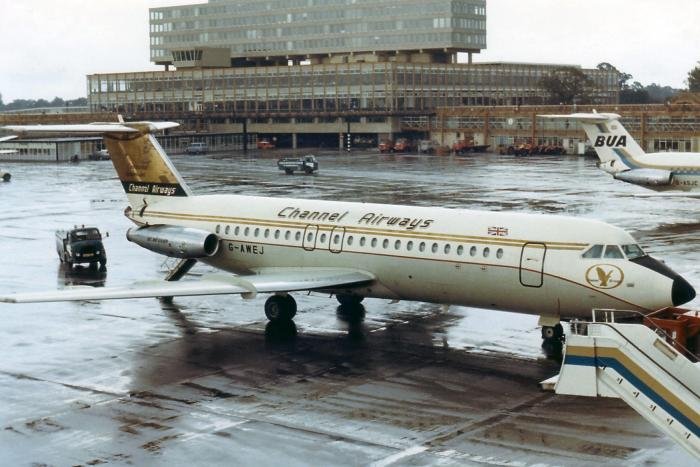
Jones used to say, “The aircraft aren’t earning me a penny when they’re not flying”. This was the philosophy behind the rapid turnaround times achieved by the airline. “We got them down to 25 minutes”, Mike Kay recalls. “It was a brilliant operation. The One-Elevens were wonderful aircraft in this respect.”
The general economic gloom that followed the devaluation of sterling caused Channel Airways to cancel its outstanding jet orders. It took only three One-Elevens and the two Tridents. It also lost £300,000 in deposits. But Jones was also able to announce a provisional pre-tax profit for 1968 of £520,000 on a turnover of £4.5 million. This compared with profits of £726,000 for 1965, £765,000 for 1966 and £730,000 for 1967.
By the late 1960s Channel was a leading provider of IT holiday seats to major tour operators. One contract, for a Belgian firm, involved 30 flights every weekend on the Southend-Ostend link. The new decade was celebrated with further contracts, including one valued at £5 million. This, together with additional scheduled services, highlighted a need for more capacity. Five ex-BEA Comet 4Bs were acquired for £2 million.
The airline’s burgeoning IT business brought the introduction of an in-house tour-operating subsidiary, Mediterranean Holidays. By 1971 there were contracts with West German tour operators worth a combined £11 million, for a programme involving more than 50 flights a week from West Berlin to Mediterranean resorts in southern Europe and North Africa. One jet was permanently based at West Berlin’s Tegel airport, and shorter-range operations were also conducted from Tempelhof, but restrictions imposed by the length of Southend’s runway and complaints about noise from the One-Elevens brought a move to Stansted in 1968.
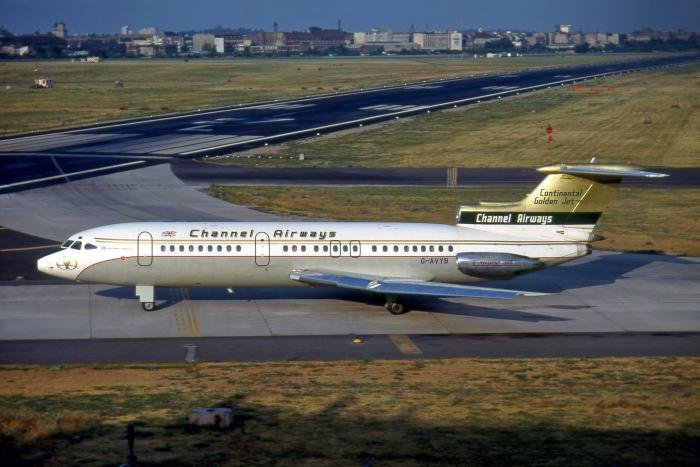
What’s more, the airline was considering entering the North American affinity group charter market. “I was sworn to secrecy”, Michael Steed recalls, “when Jack went off to Washington for 10 days for discussions”. There was talk of acquiring a pair of Boeing 707s, but nothing came of it.
Steed remembered Jones as a man of “huge energy”, who seemed to be working “all the time”. Yet he was strangely self-effacing and had to be persuaded to raise his profile when the occasion demanded, such as the launch of the ‘Scottish Flyer’ with its attendant national press coverage.
Michael Steed left in the late 1960s to work for a tour operator. “I was glad to go”, he says. “I was worried about the future. I was aware there had been critical talks with the bankers each autumn.”
Channel Airways was becoming an increasingly seasonal operation reliant on the IT market. In 1971 it carried 386,000 charter passengers and 155,000 scheduled. But the real difference was highlighted by the output statistics: in terms of passenger miles flown, scheduled services represented just nine per cent of the total. That summer season was aggravated by a lack of spares for the jets, particularly the Comets and Tridents, a situation partially resolved when the tri-jets were sold to BEA.
That winter the four Comets and two One-Elevens were left idle as the four Viscounts, two Herons and a Dove continued to operate services mostly from Southend. The Stansted engineering base was closed at the end of January 1972. A week later a nervous Barclays Bank appointed a receiver and put the airline up for sale.
The truth was that life was tough for an independent airline. Michael Steed recalled the constant battle over route licence applications. “BEA objected to everything. We had to make a case on the basis of there being enough passengers to make the operation profitable. The obstacles were colossal.”
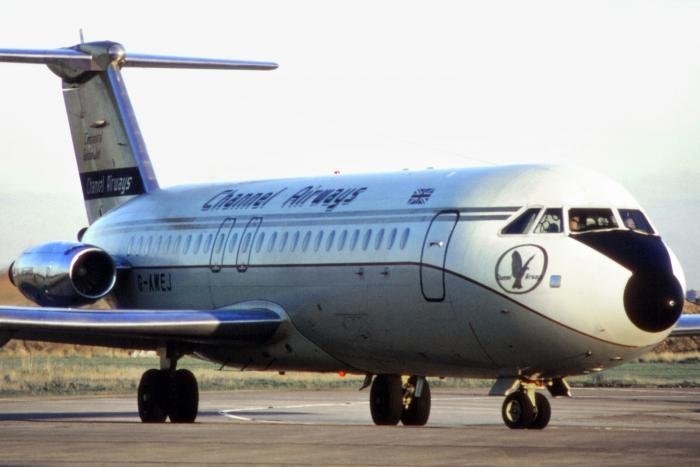
The air operator’s certificate was withdrawn in March and some of the scheduled routes were awarded to other airlines: British Midland and Dan-Air got the Channel Islands routes. Dan-Air also acquired the Comets and expanded its Berlin operations at Channel Airways’ expense.
It was a sad end to the airline that Jack built. Jones died in 2006, aged 94. He was, says Gerry Kay, an “old rogue”. But he was also a man of vision, and one of British air travel’s unsung trailblazers. The likes of easyJet owe more than they might think to Channel Airways and its ‘Continental Golden Jets’.

